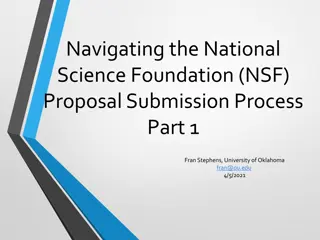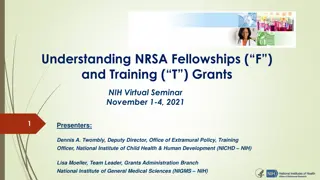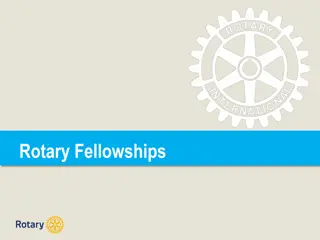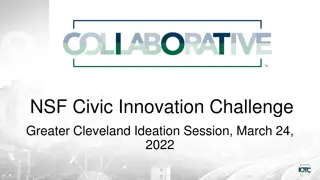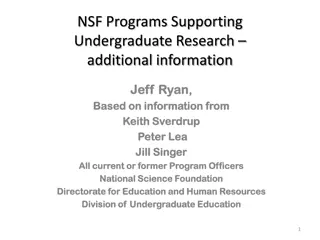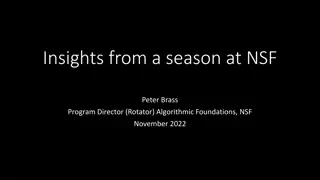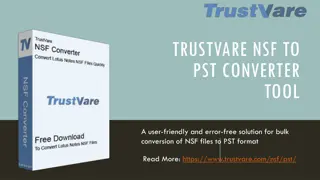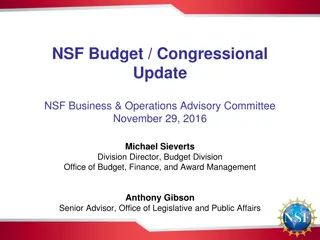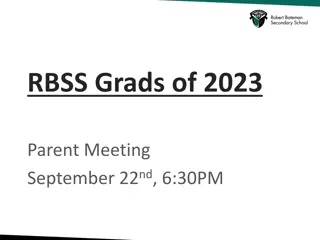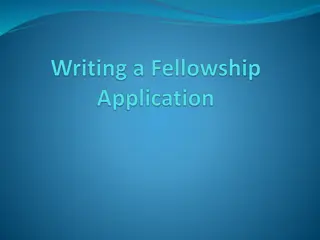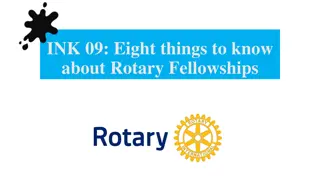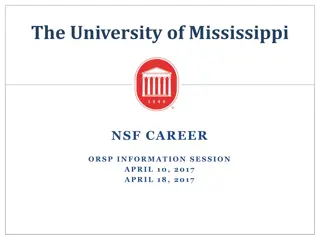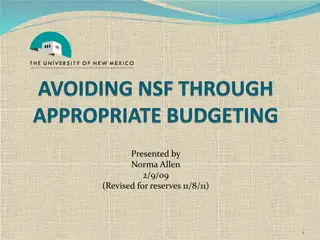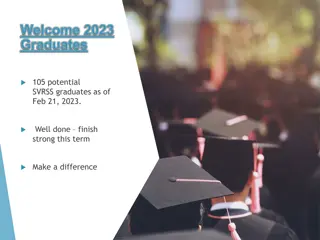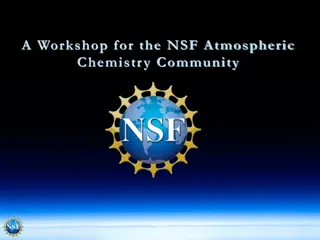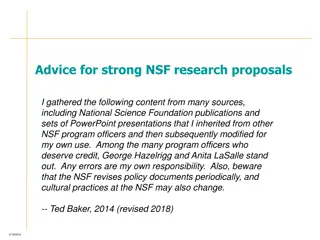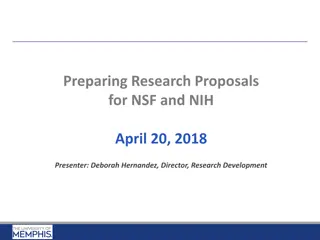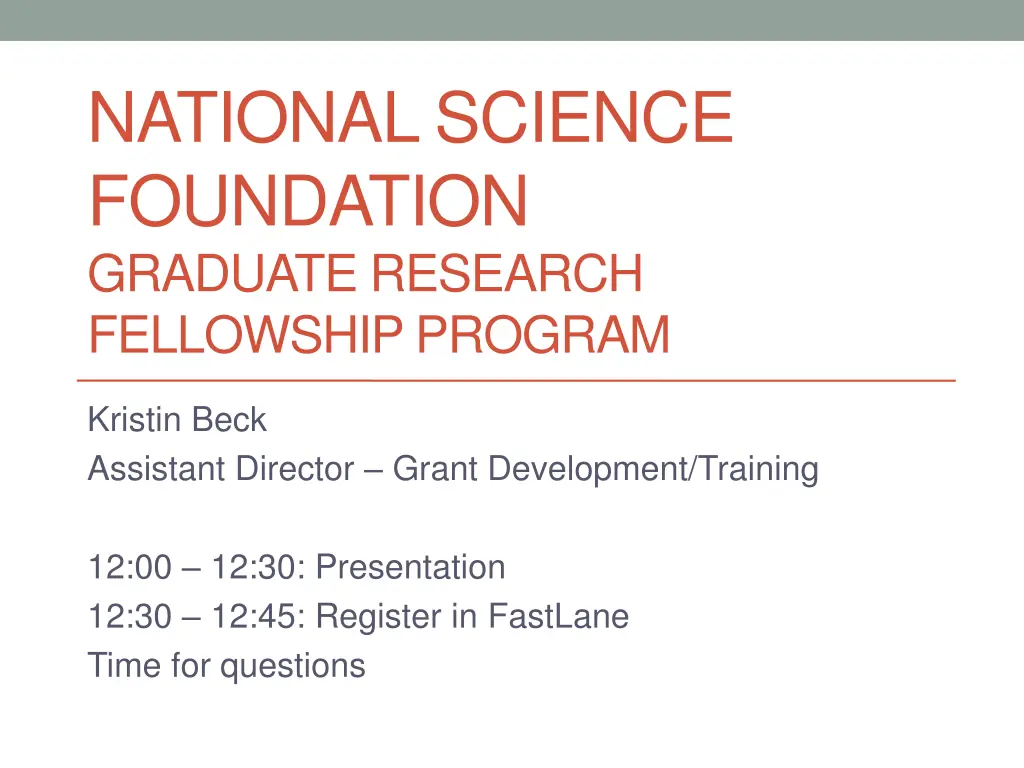
NSF Graduate Fellowship Program: Funding for Science and Engineering Studies
"Learn about the NSF Graduate Fellowship Program that supports outstanding graduate students in science and engineering fields. Discover eligibility criteria, program goals, funding details, and application process to advance your research career."
Uploaded on | 4 Views
Download Presentation

Please find below an Image/Link to download the presentation.
The content on the website is provided AS IS for your information and personal use only. It may not be sold, licensed, or shared on other websites without obtaining consent from the author. If you encounter any issues during the download, it is possible that the publisher has removed the file from their server.
You are allowed to download the files provided on this website for personal or commercial use, subject to the condition that they are used lawfully. All files are the property of their respective owners.
The content on the website is provided AS IS for your information and personal use only. It may not be sold, licensed, or shared on other websites without obtaining consent from the author.
E N D
Presentation Transcript
NATIONAL SCIENCE FOUNDATION GRADUATE RESEARCH FELLOWSHIP PROGRAM Kristin Beck Assistant Director Grant Development/Training 12:00 12:30: Presentation 12:30 12:45: Register in FastLane Time for questions
Overview What is the NSF Graduate Fellowship program? Program goals Eligibility How to apply Deadlines Proposal elements
NSF Graduate Fellowship Program Supports outstanding graduate students who are pursuing research-based master s and doctoral degrees in science and engineering: Computer & Information Science & Engineering Chemistry Engineering Geosciences Life Sciences Materials Research Mathematical Sciences Physics & Astronomy Psychology Social Sciences STEM Education & Learning Research
Program Goals 1. Select, recognize and financially support individuals early in their careers with the demonstrated potential to be high achieving scientist and engineers 2. Broaden participation in science and engineering of underrepresented groups (women, minorities, persons with disabilities, veterans)
Program Offers Funding for 3 (out of 5 years of graduate school) Stipend: $34,000/year Tuition: $12,000/year Access to supplemental funding to sustain research while on medical deferral (e.g. family leave)
Eligibility be a US citizen, US national, or permanent resident intend to pursue a research-based Master s or Ph.D. program in a GRFP-supported field be enrolled in an eligible program at an accredited United States graduate institution, with a US campus, by fall following selection be at an early stage in your graduate career have completed no more than one academic year of full- time graduate study (or the equivalent) Graduate students are limited to only one application to the GRFP, submitted either in the first year or in the second year of graduate school
How to Apply Must register with FastLane Need three reference letters by the deadline (submitted electronically through FastLane GRFP Application Module) Submit the following through the FastLane GRFP Application Module: Personal Information; Education and Other Experiences; Background and Future Goals Statement; Graduate Research Plan Statement; Eligibility Statement; Transcripts; Names & Emails of References
Standard Application Information Times New Roman font for all text Cambria Math font for equations Symbol font for non-alphabetic characters recommended that equations and symbols be inserted as an image no smaller than 11-point except text that is part of an image
Proposal Sections Personal, Relevant Background, and Future Goals 3 pages Graduate Research Plan Statement 2 pages Page limits include references, citations, charts, figures, images, list of publications and presentations Both statements must address NSF s review criteria of Intellectual Merit and Broader Impacts. Applicants should address Intellectual Merit and Broader Impacts under separate headings to provide reviewers with the information necessary to evaluate the application with respect to both criteria.
Proposal Sections Transcripts Required for all institutions listed by the applicant in the FastLane GRFP Module Required from baccalaureate institution and for all graduate work with a start date prior to the following Fall term Redact personally identifiable information (date of birth, SSN) before uploading
Proposal Sections Three Reference Letters From non-family members Uploaded by reference 2 page limit per letter Should address NSF Merit Review Criteria of Intellectual Merit and Broader Impacts, include details explaining nature of relationship, comments on the applicant s potential for contributing to a globally- engaged US science and engineering workforce, applicant s academic potential and prior research experiences, statements about applicant s proposed research. Recommended you provide a copy of your application materials to your reference
Review Criteria What is the potential for the proposed activity to: Advance knowledge & understanding within its own field or others Benefit to society or advance desired societal outcomes Proposed activities suggest and explore creative, original, or potentially transformative concepts Plan for carrying out proposed activities well-reasoned, well-organized, and based on sound rationale? Plan to assess success? How well qualified is in the individual or team? Adequate resources available to carry out the research?
If you want to apply Read the solicitation: https://nsfgrfp.org/applicants/grf-program-solicitation/ Work closely with your advisor or faculty member Contact myself @ krbeck@nmu.edu to assist in submitting your proposal
Deadlines October 18 Life Sciences October 19 Computer and Information Science and Engineering, Materials Research, Psychology, Social Sciences, STEM Education and Learning October 21 Engineering October 22 Chemistry, Geosciences, Mathematical Sciences, Physics and Astronomy October 29 Reference Letter Deadline
How to register in FastLane We will do it now! https://www.research.gov/grfp/Login.do
Personal Statement Must address: Personal, Relevant Background, Future Goals statements 3 Pages: Introductory paragraph Personal, Professional, Educational Experiences Competencies, Team/Interdisciplinary Skills, Leadership Career Aspirations Intellectual Merit and Broader Impacts Concluding Paragraph
Research Plan 2 pages Title Keywords Introduction Hypothesis Research Plan Anticipated Results Intellectual Merit and Broader Impacts References (Literature Citations)
Statement Hints Clearly Label Statement Headings Keep in mind that NSF does not just seek to fund scientists and engineers; NSF seeks to fund future STEM leaders. Be yourself. Use appropriate scientific form (hypothesis, figures, references) in the Graduate Research Statement. Don't get bogged down in the specifics, or be overly technical. Develop a consistent theme in both of the statements.
Additional Resources database for proposals https://www.alexhunterlang.com/nsf-fellowship additional tips http://www.malloryladd.com/nsf-grfp-advice.html Gradcafe: gradcafe.com
Questions & Contact Info Kristin Beck krbeck@nmu.edu 906-227-1893

